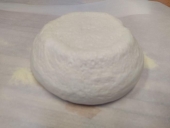I use grape jelly in my tomato sauce for meatballs and pizza.
You read that right: GRAPE JELLY. It adds sweetness and kinda makes things stick to your mouth and tongue.
You can add so many different things to a sauce to dress it up that books are written on the subject. Sauces can be sweet, tangy, zesty, herbal, meaty, oily, mild, strong...where do you want to take it? You can roast, broil, simmer, and caramelize ingredients until the cows come home.
I took a few months off not too long ago, went north to visit folks, stayed with my sister. She turned me on to a
Pizza Stone. I simply had to have one! figure on $40 bucks. If you don't have a brick oven, its the next best thing. Also, look at a pizza peel. Sister makes her dough in a bread machine, comes out fine, but she tends to not let it rise enough. No matter.
She has 2 teenage boys. They'll eat anything you put in front of them and ask for more. Dough is important, toppings are whatever you like, but its the sauce that sets your pizza apart.
You can grow and harvest your own tomatoes, selecting a blend of heirloom cultivars to serve as the foundation of your sauce. I recommend Amish Paste, Red Fig, plus a brandywine to round it out. Simmer long and slow for a day or two. Reducing the water content is the objective. Start with a full pot, take it down to half a pot at least. Concentrate that flavor. You can make the entire sauce with cherry tomatoes. This will produce a sweet sauce. Golden tomatoes have a unique appearance, but the sauce tends to head in the brown direction. Roma tomatoes work well. Your sauce would have fewer seeds and will be thicker sooner. You can spend years developing a killer sauce. Lets look at a shortcut.
There are dozens of tomato sauces on the market. Some are produced to sell fast and cheap to people with no tastebuds. Some are produced to taste pretty good, but the target is a wide demographic. As a result, the spices are toned down, flavors are mild. For storebought tomato sauces, check the label. If tomato puree is listed, move on to the next maker. Tomato puree tells me nothing about the water content other than it is probably boosted to increase production yield. It's tomato paste with water added. Watered down sauce does not make a good pizza.
To make tomato paste, simmer that pot of tomatoes down to about 10% of its starting volume, then run it through a Foley to get the seeds out. That's 10 pounds of tomato flavor squeezed into a pint of sauce. Tasty? Sure. Too much? Well, it can be. A good sauce will have flavor, but it also needs texture. Tomato puree and tomato paste will have a texture not unlike baby food.
Try out a few sauces. Find one that you like. Then learn how to improve upon it. Bertolli is pretty good, comes in a mason jar. Prego is ok for a start. Heinz, to me, is the same as ketchup. No...its much worse than ketchup. Hunts has a premium sauce with decent flavor, but it needs much work. Starting with a commercial sauce can give you a decent base without simmering all day. Now lets make it better.
Tomatoes are available in the produce section. You can grab a few to add to your sauce. Chop into chunks, toss them in the pot. If you wish to remove the skins, dip them in boiling water for a few seconds, then get to chopping. Alternately, there is a wide range of tomato products in cans-whole peeled, sliced, diced, chopped, slopped, dropped, drooped and gooped. The bigger the chunks, the more texture your sauce will have. Chunky sauce on a pizza is pretty good. If you like it smooth, you can use the stuff straight from the sauce jar with no added tomato. Whatever your texture preference, the next step is working on tomato flavor. For tomato flavor, add tomato paste. I put in a 6 oz can of paste for every pint of sauce. You may wish to start with 6 oz of paste for every quart of sauce, then add more until you decide to skip the pizza and just eat the sauce.
HERBS
You've got the start of a good sauce. Herbs can be added to develop the nose of the sauce. Flavor does not come from taste buds, it comes from the nose. Different herbs, and when they go into the sauce will make a difference in the end. Oregano and basil are the most common herbs used. Fresh is best. For oregano, just pluck the leaves off the stem. Basil can be chopped or left whole. Oregano added early in the simmer will add more flavor as the aromatic oils are extracted. Basil is the opposite, breaking down and becoming more mild the longer it is simmered. If using dry herbs, you'll want to add them sooner than you would fresh in order to allow time for rehydration. Thyme is flavorful, but can be overpowering. Rosemary and tarragon might be something you want to try. Herbs offer pungency, nuttyness, sweetness, aroma and character. If you are new to working with herbs, bear in mind that limiting a recipe to a couple of herbs is the way to produce a distinctive entree. Adding in all kinds of herbs makes slop.
GARLIC
Repeat after me: There is no such thing as too much garlic.
As you cook garlic, the flavor will become gentler. If you like it to kick you in the head and make your eyes tear up, add it in late in the simmer.













































































